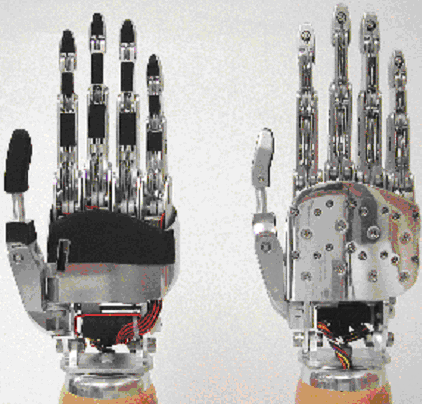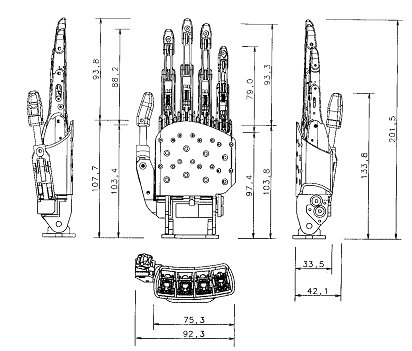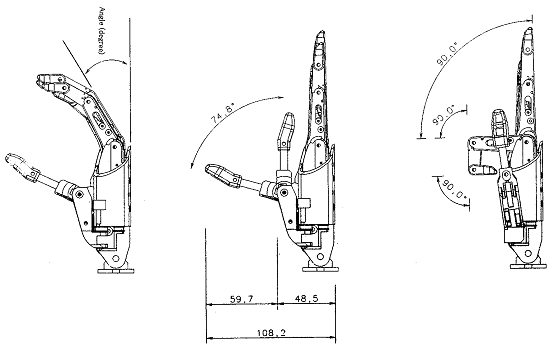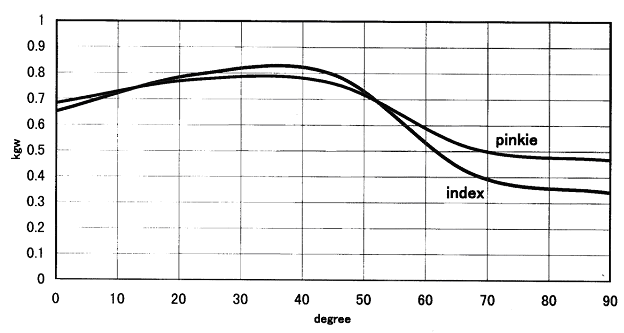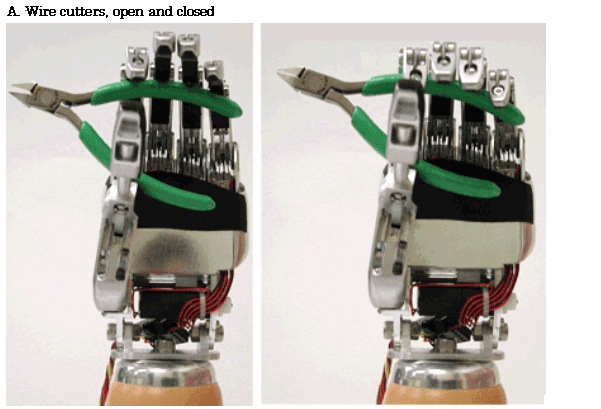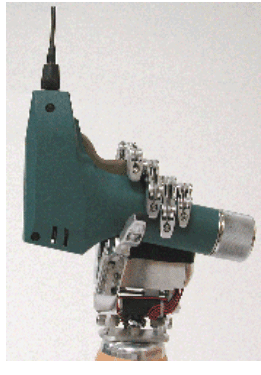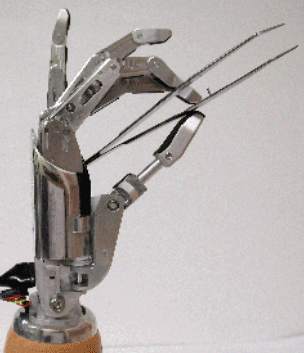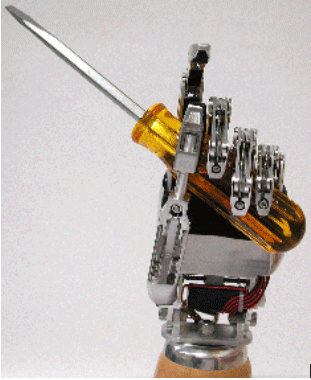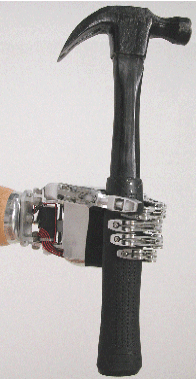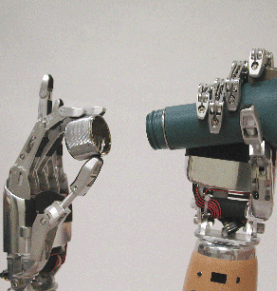Investigation of the Harada Robot Hand For SpaceD. Keymeulen and C. Assad, Jet Propulsion Laboratory, California Institute of Technology, 4800 Oak Grove Dr., Pasadena, CA 91109 I.Introduction We report on the Harada hand, a 5 degree of freedom (DOF) robotic hand designed and constructed by Harada Electric Industry Inc. of Japan [10]. The hand was originally developed for prosthetic applications, including the form and function of the human hand and interface electronics for myoelectric control from muscle activity in the forearm. Here we describe its characteristics and evaluate its potential for use in space applications, such as in space telerobotic assistants for Extra Vehicular Activities (EVA) or anthropomorphic robots for outposts on Mars. Space applications are often designed with tools and control interfaces meant to be manipulated by human hands. Therefore dexterous robotic manipulators designed to participate in those tasks will share many of the functional requirements of prosthetic hands. Both robotic hands and prosthetic hands must approach the level of manipulative dexterity and grasp robustness found in the human hand. They also must entail minimal effort to control by human operators. These requirements dictate that the robotic hand must be of anthropomorphic design to mimic the human hand in form and function, for most natural use by operator (in telerobotics or prosthetics), and for space applications such as EVAs where the robot will be required to manipulate tools designed for astronauts in space suits. II. Harada Hand: Design The Harada robot hand is shown in Figure 1. It has four fingers and a thumb built to approximate dimensions of the human hand (see Table 1). Each of the four fingers has three links and three revolute joints to pitch the finger forward out of the plane of the palm. Each of the fingers each has one motor supplying one independent DOF. The motor controls the finger by pulling a tendon cable over a carefully engineered pulley system that bends each joint approximately equally in angle. The joints can rotate each to 90 degrees in pitch, and are spring loaded to provide return torque when the tendon is slackened. Finger lengths, weights and joint angle ranges are summarized in Table 1. The thumb has two links with two revolute joints. As in each finger, it only has one motor for actuation, but the motor drives 2 motions around 2 different joint axes in series. The thumb starts from a vertical position alongside the palm (as shown in Fig. 1). As the lead screw turns, the tendon system first rotates the base joint 90 degrees to bring the thumb in front of the palm, and next hyper-extends the 2ndjoint out to a maximum of 74 degrees from the plane of the palm (see Fig. 2). This limited motion of the thumb approximates one DOF motion of the human thumb and allows some grasps that require the thumb in opposition to the fingers. However, it is greatly restricted from the range of motion of a real human thumb. All motors and gearing are located within the rigid palm. The motors are manufactured by Namiki Precision Jewel Company, type 12CL-20N08 G120 (15:1), with no load current maximum of 120 mA and starting torque 29.4 mN.m at 2.15 Aoperated from a 5 V power supply [1]. They are controlled through a computer interface which takes TTL level inputs representing commands for finger contraction and extension, and converts them to 5 V drive signals for each motor. Control inputs can also be generated from myoelectric signals (muscle activity) recorded with EMG electrodes placed on a human forearm, and processed by a custom pattern recognition circuit built into the robot forearm cavity [2].During operation with no load on the fingers, the motors can drive the fingers from fully extended to fully contracted (all joints bent to 90 degrees) in just over 2 seconds, at an approximate angular velocity of 45 degrees/second about each joint. Figure 1Harada hand (front and back).
Bottom. Hand dimensionsfrom [1](units: mm)
Table 1. Harada hand dimensions
Figure 2.Kinematics of the fingers, from [1].
Figure 3.Torque vs bending degree for the index and pinkie fingers, from [1].
Table 2. Torques and bending time, from [1]
The hand is incomplete in that the current prototype has no sensor feedback. The major drawback is that it has neither motor encoders nor joint encoders to give feedback on the positions of the joints. There are also no load sensors for force feedback or tactile sensors for sensing surface contact. This will certainly need to be corrected in future versions of the hand before any sophisticated control methods can be used for space applications. III. Harada Hand: Manipulative DexterityOur main goal was to evaluate the Harada hand for its manipulative dexterity and grasping robustness. Many ground breaking dexterous robot hands have been developed over the past two decades [9]. These devices make it possible for a robot manipulator to grasp and manipulate objects that are not designed to be robotically compatible. While several grippers have been designed for space use and some even tested in space, no dexterous robotics hand has been flown in EVA conditions. Only the Robonaut Hand has been under development for space EVA use [6]. The Harada hand, although designed for prosthetic applications, have multiple features that made the hand suitable for EVA use such as:
In its present state, the hand is limited by several constraints:
Given these limitations, we wanted to examine what types of tasks can still be performed under such a constrained system. In the following figures and Table 2, we present preliminary data gathered during experiments to evaluate grasps of various tools designed to be used by the human hand. Table 2. Tool grasp and manipulation results
@ @ Figure 4. Grasps of various tools
B. Wire wrap gun
C.Forceps
D.Screw driver
E.Crescent wrench
F.Hammer
G. Threaded screw task
IV.Comparison to NASA Robonaut handAs described above, the Harada hand was designed as an effective and relatively affordable prosthetic hand. How does it compare to hands designed for space telerobotics? Here we compare features with the NASA Robonaut hand, a custom built state-of-the-art robotic hand designed to be integrated with a humanoid robot for in space telerobotic operations [5, 6, 11]. The NASA Robonaut was designed to reduce the time and effort spent by astronauts during EVAs, to carry out repairs or other manipulations outside the spacecraft.When operated telerobotically from within the space craft,it will eliminate the need for human EVAs for certain tasks. Therefore the Robonaut needs to be fit to the tools and interfaces designed for human use in space suits, and the hands are designed to approximate the kinematics and strength of an astronaut hand in a space suit. To manipulate the typical tool packages, the hands are required to exert a maximum force of 20 lbs and maximum torque of 30 in-lbs. There are also requirements on the components that are unique to the space environment; for example, the materials should allow no out gassing and be tolerant of wide temperature swings, and the hands use brushless motors with proven space lubricants to work in vacuum. The Robonaut hand is comprised of 4 fingers, opposable thumb, palm, wrist and forearm. There are 14 motors with control electronics built into the 8 inch long forearm, that give the hand 14 independent DOF.In general, the high DOF allows the hand to manipulate objects while maintaining stable grasp control.The index and middle fingers are designed to be dexterous for fine manipulation tasks. They each have 3 joints/links, with 3 independent DOF: 2 at the base joint (pitch to +100 degrees from vertical, yaw }25 degrees) and 1 for the pitch of the distal 2nd and 3rd joints at equal angles (pitch +90 degrees each). The ring and pinkie fingers are designed to help maintain stable grasp. They each have 3 joints/links, but only 1 DOF, so all joints bend approximately equally to +90 pitch. The opposable thumb has 2 joints/links with 3 DOF: the base can yaw 70 degrees and pitch 110 degrees, while the distal joint can pitch up to 80 degrees. The drives for the fingers avoid tendons and pulleys by using flex shaft drive trains. Pitch joints are spring preloaded for return, while the yaw joints use antagonistic cable pairs. The palm adds 1 DOF to cup tools for stable grasps, while the wrist contributes an additional 2 DOF (pitch }70 degree, yaw }30 degree) To enable feedback control for the hand, 43 sensors are integrated into the fingers and motors. Each motor contains one incremental position encoder, while each joint has one absolute position encoder.In addition, each finger has one strain gauge and the wrist has two load cells for force feedback.Currently there are no tactile sensors, although they may be added in future implementations.The control for the hand was too difficult to solve with analytical models alone, so the kinematics and dynamics are calculated empirically, from putting the hand through its motions. Also the motors cannot be back driven ? so if power fails, the grasp can remain closed. More details can be found in [6]. The Robonaut hands have undergone testing for various tasks with tools designed for space, scientific and medical environments [7, 8].Space tools included torque tools, EVA tether hooks, Velcro fasteners, fabric tool kit, control panels, and large and small PIP pins. There is also potential application to manipulation of rocks and the tools needed to examine them, for a grobotic geologisth. Scientific and works tools tested have included wire cutters and strippers, power drills, flashlights, and socket and crescent wrenchs. Medical instruments include forceps, syringe and scalpel among others.In general the results have confirmed that many of these tasks can be effectively performed under telerobotic control with these highly dexterous hands. However, there are still several limitations and room for improvement before the current robotic manipulators can meet the demands of complex space tasks.Work on the Robonaut continues at NASAfs JohnsonSpaceCenter. V. ConclusionsThe Harada hand is a beautiful job of engineering. It should prove more effective than most existing commonly used and affordable prosthetic hands. For space applications it still requires some improvements: more DOF (particularly for the thumb and index finger), sensor feedback (joint position and motor encoders, force transducers, tactile sensors for the fingertips), and the materials properties would have to be qualified for the space environment.Here we have reported preliminary results to characterize the capabilities of the initial prototype Harada hand. We will continue this work by attaching the hand onto a 5 DOF arm with wrist, adding several sensing devices, and controlling the arm and hand through a telerobotics interface. Harada Elecronics Industry Inc. is currently working on an improved next generation hand, which we expect will be a very capable and useful tool for human-like manipulation. The research described in this paper was performed at the Center for Integrated Space Microsystems, Jet Propulsion Laboratory, California Institute of Technology, and was sponsored by the National Aeronautics and Space Administration. VII. References[1]Operating Manual for the Myoelectric Prosthetic Hand. Harada Electronics Industry, Inc. December 2000 [2]Kajitani I, Murakawa M, Nishikawa D, Yokoi H, Kajihara N, Iwata M, Keymeulen D, Sakanashi H, Higuchi T (1999) An evolvable hardware chip for prosthetic hand controller. In Proceedings of the Seventh International Conference on Microelectronics for Neural, Fuzzy and Bio-Inspired Systems, 1999. MicroNeuro '99, pp 179 -186 [3]Mason MT, Salisbury JK (1985) Robot Hands and the Mechanics of Manipulation. MIT Press, CambridgeMA [4]Cutkosky MR (1985) Robotic Grasping and Fine Manipulation. Kluwer Academic Publishers, BostonMA [5]Ambrose RO, Aldridge H, Askew RS, Burridge RR, Bluethmann W, Diftler M, Lovchik C, Magruder D, Rehnmark F (2000) Robonaut: NASAfs Space Humanoid. IEEE Intelligent Systems, July/August 2000, pp 57-62 [6]Lovchik CS, Diftler MA (1999) The Robonaut Hand: A Dexterous Robot Hand for Space. Proceedings of the 1999 IEEE International Conference on Robotics & Automation, Detroit, pp 907-912 [7]Li L, Cox B, Diftler M, Shelton S, Rogers B (1996) Development of a Telepresence Controlled Ambidextrous Robot for Space Applications.Proceedings of the 1996 IEEE International Conference on Robotics & Automation, Minneapolis, pp 58-63 [8]Diftler MA, Walker ID (1999) Experiments in Aligning Threaded Parts Using a Robot Hand. IEEE Transactions on Robotics and Automation 15 (5):858-868 [9] Bicchi, A. (2000) hands for Dexterous Manipulation and Robust Grasping: A Difficult Road Toward Simplicity. IEEE Transactions on Robotics and Automation 16 (6) 652-662. Piscataway, NJ: IEEE press. [10] Harada Electric Industry Inc., http://www.h-e-i.co.jp/ [11] Robonaut, JohnsonSpaceCenter, NASA, http://vesuvius.jsc.nasa.gov/er_er/html/robonaut/robonaut.html |
|||||||||||||||||||||||||||||||||||||||||||||||||||||||||||||||||||||||||||||||||||||||||||||||||||||||||||||||||||
